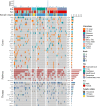Clinical significance of genetic profiling based on different anatomic sites in patients with mucosal melanoma who received or did not receive immune checkpoint inhibitors
- PMID: 37649078
- PMCID: PMC10469937
- DOI: 10.1186/s12935-023-03032-3
Clinical significance of genetic profiling based on different anatomic sites in patients with mucosal melanoma who received or did not receive immune checkpoint inhibitors
Abstract
Background: To date, data on the efficacy of targeted therapies for mucosal melanoma (MM) are limited. In this study, we analyzed genetic alterations according to the primary site of origin, which could provide clues for targeted therapy for MM.
Methods: We conducted a retrospective cohort study of 112 patients with MM. Targeted sequencing was performed to analyze genetic aberrations. Kaplan-Meier analysis was conducted with the log-rank test to compare the significance among subgroups.
Results: In total, 112 patients with MM were included according to the anatomic sites: 38 (33.9%) in the head and neck, 22 (19.6%) in the genitourinary tract, 21 (18.8%) in the anorectum, 19 (17.0%) in the esophagus, 10 (8.9%) in the uvea, and 2 (1.8%) in the small bowel. The most significantly mutated genes included BRAF (17%), KIT (15%), RAS (15%), TP53 (13%), NF1 (12%), SF3B1 (11%), GNA11 (7%), GNAQ (5%), and FBXW7 (4%). A large number of chromosomal structural variants was found. The anatomic sites of esophagus and small bowel were independent risk factors for progression-free survival (PFS, hazard ratio [HR] 4.78, 95% confidence interval [CI] 2.42-9.45, P < 0.0001) and overall survival (OS, HR 5.26, 95% CI 2.51-11.03, P < 0.0001). Casitas B-lineage lymphoma (CBL) mutants showed significantly poorer PFS and OS. In contrast, MM patients who received immune checkpoint inhibitors (ICIs) had a significantly more favorable OS (HR 0.39, 95% CI 0.20-0.75, P = 0.008).
Conclusions: Our findings reveal the genetic features of patients with MM, mainly across six anatomic sites, offering a potential avenue for targeted therapies.
Keywords: Clinical significance; Genetic alterations; Mucosal melanoma; Primary site; Prognosis.
© 2023. BioMed Central Ltd., part of Springer Nature.
Conflict of interest statement
The authors declare that they have no known competing financial interests or personal relationships that may have influenced the work reported in this study.
Figures




Similar articles
-
Patients with melanoma treated with immune checkpoint inhibitors who had non-thyroid endocrine and skin immune-related adverse events have better prognosis: A systematic review and meta-analysis.Front Oncol. 2022 Sep 14;12:976224. doi: 10.3389/fonc.2022.976224. eCollection 2022. Front Oncol. 2022. PMID: 36185176 Free PMC article.
-
NF1-mutated melanomas reveal distinct clinical characteristics depending on tumour origin and respond favourably to immune checkpoint inhibitors.Eur J Cancer. 2021 Dec;159:113-124. doi: 10.1016/j.ejca.2021.09.035. Epub 2021 Nov 4. Eur J Cancer. 2021. PMID: 34742158 Free PMC article.
-
Recurrent hotspot SF3B1 mutations at codon 625 in vulvovaginal mucosal melanoma identified in a study of 27 Australian mucosal melanomas.Oncotarget. 2019 Jan 29;10(9):930-941. doi: 10.18632/oncotarget.26584. eCollection 2019 Jan 29. Oncotarget. 2019. PMID: 30847022 Free PMC article.
-
Biologic subtypes of melanoma predict survival benefit of combination anti-PD1+anti-CTLA4 immune checkpoint inhibitors versus anti-PD1 monotherapy.J Immunother Cancer. 2021 Jan;9(1):e001642. doi: 10.1136/jitc-2020-001642. J Immunother Cancer. 2021. PMID: 33483342 Free PMC article.
-
Effect of liver metastasis on the efficacy of immune checkpoint inhibitors in cancer patients: a systemic review and meta-analysis.Clin Exp Metastasis. 2023 Aug;40(4):255-287. doi: 10.1007/s10585-023-10217-7. Epub 2023 Jun 13. Clin Exp Metastasis. 2023. PMID: 37308706
Cited by
-
Advances in immunotherapy for mucosal melanoma: harnessing immune checkpoint inhibitors for improved treatment outcomes.Front Immunol. 2024 Jul 30;15:1441410. doi: 10.3389/fimmu.2024.1441410. eCollection 2024. Front Immunol. 2024. PMID: 39234260 Free PMC article. Review.
-
Cutaneous Adverse Reactions and Survival Outcomes of Advanced Melanoma Treated with Immune Checkpoint Inhibitors in an Academic Medical Centre in Singapore.Diagnostics (Basel). 2024 Jul 25;14(15):1601. doi: 10.3390/diagnostics14151601. Diagnostics (Basel). 2024. PMID: 39125477 Free PMC article.
-
Combination Immunotherapy for Mucosal Melanoma: Molecular Mechanism, Research Status, and Future Directions.Curr Treat Options Oncol. 2025 Jun;26(6):431-444. doi: 10.1007/s11864-025-01321-9. Epub 2025 Apr 25. Curr Treat Options Oncol. 2025. PMID: 40279090 Review.
References
-
- Lerner BA, Stewart LA, Horowitz DP, Carvajal RD. Mucosal melanoma: New Insights and Therapeutic Options for a unique and aggressive disease. Oncol (Williston Park) 2017;31(11):e23–e32. - PubMed
Grants and funding
LinkOut - more resources
Full Text Sources
Research Materials
Miscellaneous

